
October 18th 2008
And, today, I bring my diary up to date by writing about our trip to Atami. Atami is a town at the top of the Izu peninsular, just inside Shizuoka, the next prefecture along from Kanagawa. It has hot springs and a coast, and is close to Tokyo, which turned it into a very popular destination, first for wealthy people wanting holiday homes outside Tokyo, and then for more typical Tokyoites wanting a holiday. However, as it became cheaper and easier to travel further, it lost a lot of its business, so it had a period of decline. Apparently, it is picking up a bit again; ironically, a recession would probably be very good for it, as it cost less than a thousand yen each way for us to get there by train.
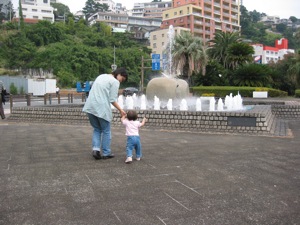 Practising walking
Practising walking
We went by ordinary train, although you can go by Shinkansen. An ordinary train involves one change rather than two, is about a quarter of the price, and only takes about ten minutes longer. Atami isn't really far enough from Tokyo to make the Shinkansen worthwhile. After we arrived, the first thing we did was walk down to the coast. There is a beach, called "Sun Beach", which was apparently made with imported sand. There's a nice park area between the beach and the road, where Yuriko and Mayuki had a little walk.
It also includes "Omiya's Pine". This relates to a famous story from the late Meiji period. Omiya was a young woman in Atami who had a boyfriend. However, the son of a banker proposed to her, with a gold ring bearing a large diamond. Dazzled by the jewel, she said yes. The pine is where she told her previous boyfriend, who stormedaway, kicking her off as she tried to stop him, declaring that she had been blinded by the gold. However, the original pine died, so the current one is a replacement, with part of the original preserved.
But the story is from a novel, so it never happened anyway. This makes the whole concept of the "orginal" pine tree more than a little problematic.
We had popped into the tourist information centre at the station, and Yuriko had found a place she would like to visit. Unfortunately, it needed a reservation, and the recommendation was to reserve months in advance. However, the tourist information person said that sometimes they had gaps on the schedule, so it was worth contacting them to see if there was a space. So Yuriko phoned them while we were in the park, and confirmed that there we could go. The visits had fixed times, so that gave us a fixed point, at 3pm.
We'd looked through the guidebook and decided where we wanted to go, and a quick bit of planning suggested that we should be able to fit in the main points around the 3pm tour. To get to the first place, we walked along the sea front. It looks like quite a lot of money has been spent on it; there are tiered walkways, looking out to sea, with about four levels. We guessed that these were primarily for the fireworks display, which the town holds over the sea in the summer, but they are also a nice place to just take it easy. There was still construction going on, which is very typical of Japan; the government spends a lot of money on concrete.
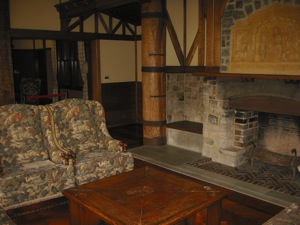 Western-Japanese fusion
Western-Japanese fusion
Our first visit was Kiunkan, a building with a slightly complex history. It was first built as a holiday home by one tycoon, then bought and expanded by another. After WWII, which it survived, it was bought again, turned into a ryokan, and further expanded. The buildings encircle a nice Japanese garden, and are a mixture of influences. Some are fairly pure Japanese, while others have a strong western influence. The photograph is of one of the western influenced rooms, looking a lot like a western sitting room, apart from the Buddhist icon built into the chimneybreast.
The whole place was very interesting. The Japanese-style rooms had traditional sand walls, but in deep blues and reds rather than the more normal sand colour. The walls themselves are not made of sand, of course; it's just a coating. Apparently, it went out of fashion because it's hard to keep clean, but it's having a bit of a renaissance. The western-style rooms had stained glass, and there was a hot spring bath room that was described as "Roman style", with gilded tiles lining the bath tubs. The central garden is fairly small, but it's a proper Japanese garden, with streams, large rocks, little hills, and winding paths that keep changing the view.
When we'd finished there, it was time to go for lunch. Relying on the guidebook, we found our way to a small sushi shop, which was very nice, and they even washed Mayuki's bottle for us, which was kind of them. After lunch, our first main stop was Kinomiya shrine, but the route there took us past another couple of interesting locations. The first is a sporadic, very small, geyser. Before the Great Kanto Earthquake in the 1920s it was quite regular, erupting every six minutes, but since then it's been less predictable, and some work was done to unblock it, so it isn't clear how natural it is any more. The rocks it erupts in look very artificial, at any rate, but as it is on the side of a street in front of a hotel, this is hardly surprising. It did erupt for us while we there, so we got to see it.
The route next took us past Yuzen Shrine, which means "Shrine in front of the hot water". It was the shrine's annual festival, and people were gathered for a prize giving. The prizes were being given to young children, but we didn't see exactly what they were for. One interesting point about the shrine was that it draws from a hot spring for the place where you wash your hands at the entrance. The water is really quite hot, so I could only dabble my fingers in it briefly. Hot water purification is almost as traditional as cold in Shinto, but, obviously, shrines with hot springs are relatively rare.
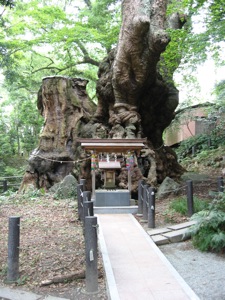 The great camphor tree at Kinomiya Shrine
The great camphor tree at Kinomiya Shrine
Kinomiya Shrine is the biggest and oldest in Atami, and its main claim to fame is a very old camphor tree that stands in the shrine precincts, and is at least as much a focus of reverence as the main shrine building. The tree is thought to be about 2,000 years old, and the shrine used to have seven. However, a couple of hundred years ago there was a big dispute over fishing rights, and the town was fined. In order to raise the money, they decided to cut the trees down. When there were only two left, it is said that an old man appeared to the woodcutters and stopped them from destroying any more.
The whole shrine complex is very pleasant, with a lot of trees and a nice pool to one side of the main shrine. I think there's a path up to the woods behind the main building, but we didn't have time to walk up there, because we had to get on to make the 3pm appointment.
The initial plan was to get the train, because there's a station at Kinomiya. However, we just missed the train, by less than a minute, and there wasn't another train for twenty minutes, which was too late. So, we got a taxi from outside the station, and made it in time.
The place Yuriko wanted to see was a house, with a lower floor designed by Bruno Taut, a famous German architect who lived in Japan in the 1930s. The lower floor is the only building he created in Japan; he spent much of his time here working on smaller items of furniture. The upper floors of the house were designed by a famous Japanese architect, whose name I have forgotten, and they are quite different from the basement.
The house is built on a cliff overlooking the sea, so that the basement has windows all along one side. Taut designed it with steps for sitting on in some rooms, a semi-Japanese room, and a large social room, as the owner of the house used these rooms to entertain guests. The design is very interesting, as it is clearly strongly influenced by traditional Japanese design -- Taut stayed here becuase he liked Japanese culture -- but also clearly influenced by the west. It is, perhaps, not surprising that it is one of the best pieces of fusion design I have seen in Japan.
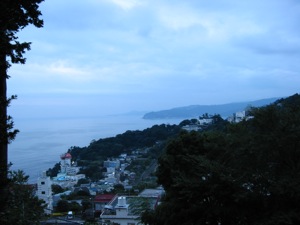 Atami from Izusan Shrine
Atami from Izusan Shrine
From there, we walked round to another shrine, Izusan Shrine. The walk there was part of the point, and although it was a bit longer than anticipated it was a very nice walk. The road went up into the hills behind the town, so there were a lot of nice views over the town and out to sea. The shrine itself was up another flight of stairs, and the staff had already gone home for the night so we just had a quick look around before going back to the road, where there was a bus stop. The walk was very nice one way, but I didn't want to do both directions carrying Mayuki.
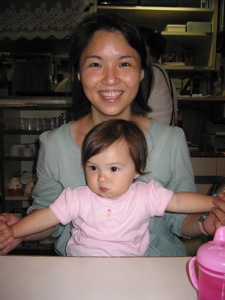 At dinner
At dinner
Back at the station, we searched for somewhere to eat dinner, as the places in the guidebook were a bit too far to go at that point. We did find somewhere, which was OK, but no more than that. That's actually quite unusual in Japan, where almost all the restaurants seem to be good. A quick check on the rail connections site that we can access on our cell phones enabled us to plan the return journey, which was also quite easy (change at Odawara), and we arrived at Noborito just in time to catch a bus back. It was evening when we got home, but not too late, and we hadn't had to leave ridiculously early, so Atami is clearly a good distance for a day trip from here, even with Mayuki.
I'm hoping to do more day trips in the future, out to the same sort of distance, because it's nice to get away with the family for a day, and it's a chance to see a bit more of Japan. There are a surprising number of places around here that Yuriko hasn't been to, for much the same reason that there are still places around Cambridge that I've never been to. When you live somewhere, it's very easy not to get around to visiting places that are nearby. I plan to make sure that Mayuki doesn't suffer from that, and has the chance to enjoy going to some different places.